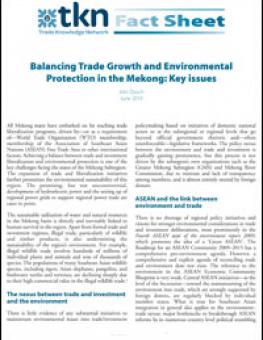
Balancing Trade Growth and Environmental Protection in the Mekong: Key issues
Achieving a balance between trade and investment liberalization and environmental protection is one of the key challenges confronting the states of the Mekong subregion (defined here as the Southeast Asian part of the Greater Mekong Subregion (GMS), comprising Cambodia, Lao PDR, Myanmar, Thailand and Vietnam). All the Mekong states have embarked on far-reaching trade liberalization programs, driven by—or as a requirement of—World Trade Organization membership, membership in the Association of Southeast Asian Nations (ASEAN) Free Trade Agreement or other international factors. The expansion of trade and liberalization initiatives further pressurizes the environmental sustainability of this region. Apart from formal trade and investment regimes, illegal trade—particularly of wildlife and timber products—is also undermining the sustainability of the region's environment.
Key findings:
-
While governments in most countries of the Mekong have been gradually adopting laws to create a simple and transparent rules-based market oriented system, the protection of the environment and the sustainable use of resources regularly take a backseat in the industrialization process that is ongoing in all these countries.
-
Overall, there is little evidence of the effectiveness of multilateral efforts—initiated by the Asian Development Bank-GMS program or the Mekong River Commission—of balancing economic interests and environmental concerns in the subregion.
-
One reason for the low level of intergovernmental commitment to environmental protection and sustainability with regard to trade and investment matters is a lack of societal lobbying and pressuring.
-
National and regional legislative and policy initiatives toward environmental protection and sustainability in general, and the forging of links between trade/investment and the environment in particular, are more often than not driven by foreign donors.
-
Until recently, the civil society impact on ASEAN policymaking was limited due to the lack of institutionalized mechanisms to facilitate relations between the ASEAN Secretariat and transnational civil society organizations/networks. The recent establishment of the Public Outreach and Civil Society Division within the ASEAN Secretariat is a step in the right direction and provides suitable channels of communication between state and non-state actors.
Key recommendations:
-
More emphasis should be given to the strengthening of the region's own institutional mechanisms and a higher level of regional ownership of the trade-environment agenda.
-
Foreign donors should intensify efforts already underway to improve the coordination of the pillars of support—bilateral projects and technical assistance, country-based ASEAN projects, and support to the ASEAN Secretariat—to ensure that synergies are achieved.
-
Coordination among donors, among ASEAN member states, between the ASEAN Secretariat and member states, and between donors and ASEAN urgently needs to be strengthened.
-
The new Public Outreach and Civil Society Division within the ASEAN Secretariat should be invested with a direct mandate to address and facilitate cooperation between state and non-state actors on environmental matters.
You might also be interested in
Will the Inclusion of Voluntary Standards in Trade Agreements Lead to More Sustainable Trade?
The use of voluntary sustainability standards (VSSs) and similar systems in free trade agreements (FTAs) is gaining traction. Will it lead to more sustainable production and consumption globally?
Strategic Environmental Assessment for the Mining Sector
Strategic environmental assessments (SEA) are an essential tool for policy-makers working to develop a sector-wide vision for responsible mining.
Blackouts and Backsliding: Energy subsidies in South Africa 2023
Blackouts and Backsliding presents the latest energy subsidy data for South Africa.
Sustainable Asset Valuation of Parques del Río Norte in Medellín, Colombia
This economic valuation demonstrates the benefits of expanding urban green space in the city of Medellín, Colombia.